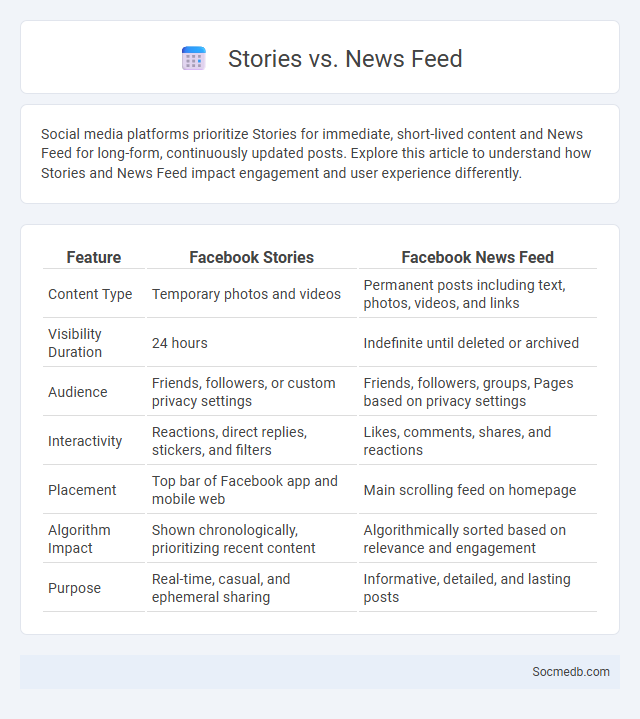
Photo illustration: Stories vs News Feed
Social media platforms prioritize Stories for immediate, short-lived content and News Feed for long-form, continuously updated posts. Explore this article to understand how Stories and News Feed impact engagement and user experience differently.
Table of Comparison
| Feature | Facebook Stories | Facebook News Feed |
|---|---|---|
| Content Type | Temporary photos and videos | Permanent posts including text, photos, videos, and links |
| Visibility Duration | 24 hours | Indefinite until deleted or archived |
| Audience | Friends, followers, or custom privacy settings | Friends, followers, groups, Pages based on privacy settings |
| Interactivity | Reactions, direct replies, stickers, and filters | Likes, comments, shares, and reactions |
| Placement | Top bar of Facebook app and mobile web | Main scrolling feed on homepage |
| Algorithm Impact | Shown chronologically, prioritizing recent content | Algorithmically sorted based on relevance and engagement |
| Purpose | Real-time, casual, and ephemeral sharing | Informative, detailed, and lasting posts |
Defining Stories, News Feeds, and Viral Content
Social media platforms curate personalized News Feeds by analyzing user interactions to prioritize Stories and content that resonate with Your interests and social connections. Stories are short, engaging, and ephemeral posts designed to capture immediate attention, while Viral Content spreads rapidly through shares, likes, and comments due to its high emotional impact or relevance. Understanding the mechanics behind these elements helps optimize content visibility and user engagement in digital marketing strategies.
Core Differences: Format and Function
Social media platforms differ primarily in their format and function, catering to varied user needs and engagement styles. Visual-centric platforms like Instagram emphasize image and video sharing, while Twitter focuses on brief text updates and real-time interaction. Understanding these core differences helps you choose the best platform to effectively share your content and connect with your target audience.
User Engagement: Which Format Wins?
Video content consistently outperforms other formats in driving user engagement on social media platforms, with reports indicating up to 1200% more shares than text and images combined. Interactive elements such as polls, quizzes, and live streams further boost engagement rates by fostering real-time participation and feedback. Infographics and short-form content like reels or stories also rank highly for capturing attention and encouraging user interaction.
Content Longevity and Visibility
Content longevity on social media significantly impacts visibility, as posts with enduring relevance attract continuous engagement over time. Platforms like Facebook and Instagram employ algorithms that prioritize content with high interaction rates, prolonging its reach beyond initial publication. Strategic use of evergreen topics and regular content updates can enhance visibility by maintaining user interest and search engine ranking.
Algorithms: How Content Gets Prioritized
Social media algorithms analyze user behavior, engagement patterns, and content relevance to prioritize what appears on your feed, ensuring the most appealing and timely posts are highlighted. These systems use machine learning to rank content by predicting what you are likely to interact with, such as likes, comments, and shares. By tailoring content based on your preferences and network activity, algorithms optimize your social media experience for maximum engagement.
Audience Targeting and Reach
Mastering audience targeting on social media enables you to deliver tailored content that resonates deeply with specific demographic groups, interests, and behaviors. Precise targeting increases engagement rates and optimizes ad spend by reaching users most likely to convert or interact with your brand. Expanding your reach through analytics-driven strategies ensures your message connects with both existing followers and new, relevant audiences, maximizing your social media impact.
Platform Examples and Case Studies
Social media platforms like Facebook, Instagram, Twitter, and LinkedIn drive targeted marketing campaigns by leveraging user data and engagement metrics to optimize content reach. Case studies reveal that Nike increased brand awareness by 20% through Instagram influencer collaborations, while Wendy's gained significant viral traction on Twitter by utilizing witty, real-time customer interactions. Businesses harnessing platform-specific features such as Facebook's Advanced Audience Targeting and LinkedIn's B2B networking capabilities achieve higher conversion rates and improved ROI.
Content Creation Strategies for Each Format
Effective content creation strategies vary across social media formats, with videos demanding concise storytelling and eye-catching visuals, while images require high-quality, shareable designs that align with your brand identity. Written posts benefit from clear, engaging captions and relevant hashtags to increase reach and interaction. Your approach should tailor content to platform-specific algorithms, maximizing engagement and driving audience growth.
Analytics: Measuring Success Across Formats
Social media analytics provide valuable insights into user engagement, reach, and conversion rates across different content formats, enabling data-driven decision-making. By tracking metrics such as likes, shares, comments, video views, and click-through rates, you can measure the effectiveness of posts on platforms like Instagram, Facebook, TikTok, and LinkedIn. Leveraging these analytics tools helps optimize your strategy to maximize ROI and enhance audience targeting.
Future Trends: The Evolution of Social Content
Future trends in social media highlight a shift toward immersive and interactive content, such as augmented reality (AR) experiences and short-form videos, that capture user attention more effectively. Artificial intelligence-driven personalization will tailor content to your preferences, enhancing engagement and relevance. Brands incorporating these innovations will shape the evolution of social content, driving deeper connections with their audiences.
 socmedb.com
socmedb.com